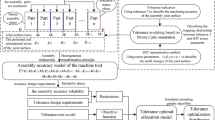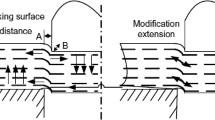Abstract
The high geometric accuracy requirement of precision machine tools represents a challenge for tolerance design and assembly process planning that guarantee the final assembly accuracy. Component tolerances should be allocated in association with assembly processes. However, tolerance design and assembly process planning are usually considered separately and lack quantitative analysis. In this paper, to integrate the geometric tolerance of components and variation propagation in assembly process, a state space model is developed. The measurement and adjustment process are expressed as observation matrix and control inputs. An optimal control problem is formulated to determine the adjustment process in consideration of the loss of final assembly accuracy and costs of remachining adjustment process. Tolerances of components can be optimally allocated based on the variation propagation in this deterministic assembly process. The generality and effectiveness of this approach are validated by applying the model on a four-axis horizontal machining center.
Similar content being viewed by others
References
Hale LC (1999) Principles and techniques for designing precision machines. Ph.D., Massachusetts Institute of Technology, Ann Arbor
Sencer B, Altintas Y, Croft E (2009) Modeling and control of contouring errors for five-axis machine tools—part I: modeling. J Manuf Sci E-t Asme 131(3):8
Lamikiz A, de Lacalle LN L, Celaya A (2009) Machine tool performance and precision. In: de Lacalle LN L, Lamikiz A (eds) Machine tools for high performance machining. Springer, London, pp 219–260
Ramesh R, Mannan MA, Poo AN (2000) Error compensation in machine tools—a review. Part I: geometric, cutting-force induced and fixture-dependent errors. Int J Mach Tools Manuf 40(9):1235–1256
Olvera D, de Lacalle LNL, Compean FI, Fz-Valdivielso A, Lamikiz A, Campa FJ (2012) Analysis of the tool tip radial stiffness of turn-milling centers. Int J Adv Manuf Technol 60(9-12):883–891
Li B, Hong J, Liu Z (2014) Stiffness design of machine tool structures by a biologically inspired topology optimization method. Int J Mach Tools Manuf 84:33–44
Uriarte L, Zatarain M, Axinte D, Yague-Fabra J, Ihlenfeldt S, Eguia J, Olarra A (2013) Machine tools for large parts. CIRP Ann Manuf Technol 62(2):731–750
Deng CY, Yin GF, Fang H, Meng ZYX (2015) Dynamic characteristics optimization for a whole vertical machining center based on the configuration of joint stiffness. Int J Adv Manuf Technol 76(5-8):1225–1242
Norouzifard V, Hamedi M (2014) A three-dimensional heat conduction inverse procedure to investigate tool-chip thermal interaction in machining process. Int J Adv Manuf Technol 74(9-12):1637–1648
Su H, Lu LH, Liang YC, Zhang Q, Sun YZ, Liu HT (2014) Finite element fractal method for thermal comprehensive analysis of machine tools. Int J Adv Manuf Technol 75(9-12):1517–1526
Zulaika JJ, Campa FJ, de Lacalle LNL (2011) An integrated process-machine approach for designing productive and lightweight milling machines. Int J Mach Tools Manuf 51(7-8):591–604
Uriarte L, Herrero A, Zatarain M, Santiso G, de Lacalle LNL, Lamikiz A, Albizuri J (2007) Error budget and stiffness chain assessment in a micromilling machine equipped with tools less than 0.3 mm in diameter. Precis Eng 31(1):1–12
Sun YZ, Chen WQ, Liang YC, An CH, Chen GD, Su H (2015) Dynamic error budget analysis of an ultraprecision flycutting machine tool. Int J Adv Manuf Technol 76(5-8):1215–1224
Slocum A (1992) Precision machine design. Prentice Hall, Englewood Cliffs
Lamikiz A, de Lacalle LNL, Ocerin O, Diez D, Maidagan E (2008) The Denavit and Hartenberg approach applied to evaluate the consequences in the tool tip position of geometrical errors in five-axis milling centres. Int J Adv Manuf Technol 37(1-2):122–139
Diaz-Tena E, Ugalde U, de Lacalle LNL, de la Iglesia A, Calleja A, Campa FJ (2013) Propagation of assembly errors in multitasking machines by the homogenous matrix method. Int J Adv Manuf Technol 68(1-4):149–164
Ahn KG, Min BK, Pasek ZJ (2006) Modeling and compensation of geometric errors in simultaneous cutting using a multi-spindle machine tool. Int J Adv Manuf Technol 29(9-10):929–939
Tian W, Gao W, Zhang D, Huang T (2014) A general approach for error modeling of machine tools. Int J Mach Tools Manuf 79:17–23
Liu HL, Li B, Wang XZ, Tan GY (2011) Characteristics of and measurement methods for geometric errors in CNC machine tools. Int J Adv Manuf Technol 54(1-4):195–201
Shen Z, Ameta G, Shah JJ, Davidson JK (2005) A comparative study of tolerance analysis methods. J Comput Inf Sci Eng 5(3):247–256
Prisco U, Giorleo G (2002) Overview of current CAT systems: review article. Integr Comput Aided Eng 9(4):373–387
Janakiraman V, Saravanan R (2010) Concurrent optimization of machining process parameters and tolerance allocation. Int J Adv Manuf Technol 51(1-4):357–369
Liu JA (2010) Variation reduction for multistage manufacturing processes: a comparison survey of statistical-process-control vs stream-of-variation methodologies. Qual Reliab Eng Int 26(7):645–661
Ding Y, Jin JH, Ceglarek D, Shi JJ (2005) Process-oriented tolerancing for multi-station assembly systems. IIE Trans 37(6):493–508
Ding Y, Ceglarek D, Shi JJ (2002) Fault diagnosis of multistage manufacturing processes by using state space approach. J Manuf Sci E-t Asme 124(2):313–322
Jin J, Shi J (1999) State space modeling of sheet metal assembly for dimensional control. J Manuf Sci E-t Asme 121(4):756–762
Chaipradabgiat T, Jin JH, Shi JJ (2009) Optimal fixture locator adjustment strategies for multi-station assembly processes. IIE Trans 41(9):843–852
Zhong J, Liu JA, Shi JJ (2010) Predictive control considering model uncertainty for variation reduction in multistage assembly processes. IEEE Trans Autom Sci Eng 7(4):724–735
Gomez-Acedo E, Olarra A, Orive J, de la Calle LNL (2013) Methodology for the design of a thermal distortion compensation for large machine tools based in state-space representation with Kalman filter. Int J Mach Tools Manuf 75:100–108
Kong LB, Cheung CF, To S, Lee WB, Du JJ, Zhang ZJ (2008) A kinematics and experimental analysis of form error compensation in ultra-precision machining. Int J Mach Tools Manuf 48(12-13):1408–1419
Mantripragada R, Whitney DE (1998) The datum flow chain: a systematic approach to assembly design and modeling. Res Eng Des 10(3):150–165
Whitney DE, Gilbert OL, Jastrzebski M (1994) Representation of geometric variations using matrix transforms for statistical tolerance analysis in assemblies. Res Eng Des 6(4):191–210
Mantripragada R, Whitney DE (1999) Modeling and controlling variation propagation in mechanical assemblies using state transition models. IEEE Trans Robot Autom 15(1):124–140
Author information
Authors and Affiliations
Corresponding author
Rights and permissions
About this article
Cite this article
Guo, J., Liu, Z., Li, B. et al. Optimal tolerance allocation for precision machine tools in consideration of measurement and adjustment processes in assembly. Int J Adv Manuf Technol 80, 1625–1640 (2015). https://doi.org/10.1007/s00170-015-7122-2
Received:
Accepted:
Published:
Issue Date:
DOI: https://doi.org/10.1007/s00170-015-7122-2




